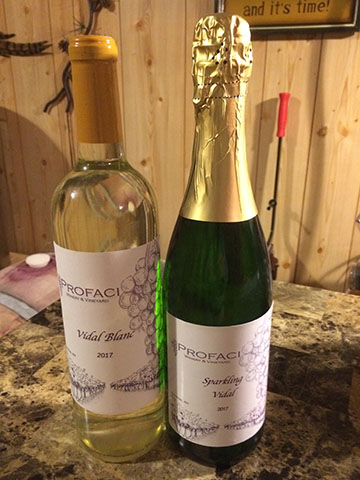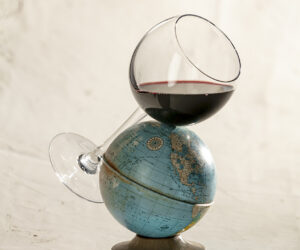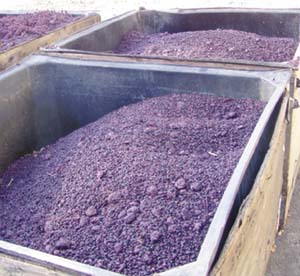
There are so many wines of different types from different grape varieties and from different winemakers available that it can truly make your head spin. Variety is the spice of life, and there is plenty of “spice” out there in the world of wine. What I find curious is that there can be so much variety even from the same grape.
An obvious example is Chardonnay; the most common white wine variety in the world. There are more vineyards planted of Chardonnay than any other white grape. So is all this Chardonnay the same? Far from it. The resultant wines from this very popular grape can and do vary widely. One reason can be from where it is grown. Chablis, which is made from 100% Chardonnay grapes, is very different from Chardonnay wines made just a bit further south in Burgundy, France; and certainly from anywhere else in the world. This is due to something known as terroir. But even that same Chardonnay from the same vineyard can become very different wines based on how the winemaker works with it. This is known as style.
Terroir
So let’s talk a little about this thing called terroir. Terroir is a French word that basically defines the place that the grape is grown. Now, you could fill books with information of how the terroir varies from one place to another. My intent here is not to get anywhere near that level of detail, and instead only to give a general idea of why this is so important to the variation of wine from one terroir to another.
Terroir is the microclimate that the grape is growing in. It is made up of things like soils, sun exposure, historical weather patterns, lay of the land, and many other factors. It defines the particular vineyard’s place in the world. Just like your home can be different from your next-door neighbor’s, so too can one vineyard be different from the neighboring one. It is even quite possible for one plot to be quite different from another in the same vineyard. This variability affects the vines planted there, which results in fruit that varies in its qualities. The terroir also dictates what varieties may be planted and, most importantly, flourish there. For example, I won’t be growing Cabernet Sauvignon or Tempranillo anytime soon here in my cold-climate of New York; barring global warming. But that’s a whole different discussion.
Just like Chardonnay can vary so dramatically from one area to another, the same is true for the red wine grapes. One example is the Nebbiolo grape growth in the Piedmont region of Northern Italy. The same grape is used to make both the Barolo and Barbaresco. Here is an example of how diverse two wines can be made from the same grape, due primarily to the different terroirs. Both are delicious, but while Barbaresco may be a full-bodied, dark fruit, and wonderful wine; it can be enjoyed young. Barolo, which has much more complexity, needs time to age and evolve in the bottle before it can be truly appreciated.
Personally, I have found a very similar phenomenon when I compare wines made from my homegrown Vidal Blanc to a neighboring winery that grows the same grape variety. While their vineyard is less than a mile away, their vines are grown on a slope while mine are on a flat landscape. This difference in the lay of the land, which accounts for temperature, drainage, sun exposure, and other variables can make quite a difference in our resultant wines from year to year. In fact, the winemaker there and I taste each other’s wines each year and are sometimes amazed at how different they can be. This keeps in mind we are employing the same style in our winemaking. Let’s explore that area next.
Style
Beyond terroir, there is another huge variable for why the same grape can produce such different wines. And that is the winemaker. Your terroir is your terroir. This is generally a given, barring Mother Nature’s annual fickleness, of what attributes your grapes will have. As a winemaker, you now have control to take those attributes and produce the best wine you can from them. Here is where a winemaker becomes an artist. It is up to them what particular style they feel would produce the best outcome from the canvas and paints they have to work with.
Let’s for a moment go back to our example of Chardonnay. Winemakers in Chablis will likely utilize the crisp and fruity nature of their grape to produce a wine that exemplifies these characteristics. While a little further south, where the grape is a bit less crisp, they may age a bit in oak and sur lie (on the lees) to add more depth and character to the wine, in Burgundian style. Now take this same grape to the New World — let’s say California — and now you may experience a wine that has been through a higher level of barrel fermentation, sur lie aging, and malolactic fermentation. The resultant wine is as far from a Chablis as you can get. Here, you experience a robust white wine that brings the oak, along with butter and nuts, front and center. Is one style better than another? That is for your palate to decide. In my opinion, all, if made well, are delicious and have a place. The place for each will vary based on your mood, what you are doing, and, of course, what you are eating.
Can every grape variety be made into multiple styles, like the wonderfully flexible Chardonnay? The winemaking community will say no. Winemakers, and more importantly wine drinkers, will tell you that certain varieties just need to be made in one fashion. A historical example of this is Riesling. Riesling, be it out of Mosel Region in Germany or the Finger Lakes of New York, has historically been made in a style to showcase its brightness and fruit, along with some of its petrol and minerality characteristics. The biggest variety in style one may have encountered would have been the level of sweetness (residual sugar) of that particular wine. The thought of making Riesling in a Burgundian style was considered a faux pas. Well interestingly, while touring the Finger Lakes region of New York recently, I came across a winery called Domaine LeSeurre located on Lake Keuka and the winemakers and owners are a young couple from Champagne, France. They have done the unthinkable and crafted a Riesling that is barrel aged. What can I say? I absolutely loved it. Much like Chardonnay, the touch of oak brings nuances of character and depth that takes Riesling to a whole different level. Of course, that is my palate’s opinion.
Taking from this experience, I’m experimenting with some of my homegrown Vidal Blanc this year. A variety that is typically high in acid and with fruit characteristics of pear, pineapple, apricot, and a citrus finish; I have typically made this in an off-dry style to balance the acid. This year, as opposed to the usual barrel-fermented and barrel-aged Chardonnay that I make, I am making a Vidal Blanc version. Luckily Vidal Blanc happens to be a variety that is very versatile in the cellar. It was originally developed as a cold-climate grape for making Cognac in France. It was later cultivated in the cold-climates of Canada and New York as a grape that is synonymous with ice wine. From my experience, it also can produce beautiful still wines that range from austere, to fruit-forward, and opulent, to sweet. Oh, and a sparkling wine that can give Prosecco a run for the money. I am fermenting the Vidal Blanc in barrel. I will age it sur lie for a number of months in the barrel. My expectation will be a fruit-forward, but much more robust white wine with more mouthfeel and depth of character. I like to call these “roast chicken” wines. In my opinion, they are a pairing made in heaven.
Can red wines be made in diverse styles too? Anyone hear of Amarone? This wine is from the Veneto Region of Northern Italy. Alright, it is not made from just one grape — it is actually made from the Corvina, Rondinella, and Molinara varieties. But so are Valpolicella and Ripasso. Each of these wines is a different style of wine made from the same grapes. Valpolicella is made in a more traditional style of just crushing, fermenting, pressing, and aging the wine. It makes for a wonderful, lighter-bodied early drinking wine. Not much there, however, to bring lasting memories.
The winemakers years ago then decided they wanted a wine with more depth, more body, more flavor, more everything. So winemakers began drying the grapes a bit before fermenting them (today they are dried under controlled conditions to remove 40% of the water). This became Amarone, a red wine with much more depth and character than Valpolicella. The wine was fermented to full dryness; which made it a bit bitter. The name Amarone means “the bitter one” in Italian. These wines are typically aged in oak casks or barrels, which ends up producing a very earthy, robust, and well-balanced wine.
Then there is Ripasso. Well now you have Valpolicella and Amarone. The Amarone has been removed from the fermentation tanks and moved to oak casks and/or barrels for aging. What is left in those tanks is pomace. The Valpolicella is pumped into the Amarone pomace and allowed to re-ferment for at least two weeks. During this time the Valpolicella picks up more color, tannin, flavor and structure. This is Ripasso. It is a wine that is somewhere between Valpolicella and Amarone.
Along with a number of red hybrids, I grow the native variety Concord in my home vineyard. As American as apple pie, it is many times viewed by the wine “connoisseur” as a variety that should not be made into wine. To this I will just say, to each his own. We each have a different palate and different sensibilities and memories that certain aromas and flavors evoke. Some good and some bad. I personally enjoy Concord wine. Of course, depending on how it is made.
When most think of Concord wine, they think of sweet wine. For the most part, just like Riesling for a time, was made just that way. Think Manischewitz. During Prohibition, this was one of the few grape varieties that were allowed to continue to be grown for winemaking, as it was used in making sacramental wines. But like everything else in fashion, wine styles change. Although there are plenty of wine drinkers out there that still love and enjoy sweet wines, there has been a movement towards drier styles. Just consider the major shift in rosé wines in the United States from sweeter blush style wines like White Zinfandel, to more dry Provence style dry rosé wines. There are a ton of them to choose from at my local wine shop. I personally make a portion of my Concord wines in an off-dry style. Concord has a relatively high acidity for a red grape. With this, a bit of sweetness is needed for proper balance; but it doesn’t have to be cloyingly sweet like the Concord wines of the past. I often blend it with a bit of Syrah or Zinfandel for complexity and then barrel age the blend. This builds additional complexity and depth from the oak tannins. It makes a wonderfully fruit-forward, novel, and approachable red table wine. Concord also lends itself to making a beautiful Port-style wine with all its wonderful fruit character. I make this every year and it is a go to after-dinner drink.
Get Creative
So I’ve touched a bit on varying wine styles coming from a few varieties, including some of the ones I grow at home. There are many others, and there are many more that will come. In fact, I’d say the options are endless. That’s what makes winemaking fun and interesting. Winemakers are an adventurous lot. They are always looking for a new twist that will make their wines stand out. They have to, as the wine industry is one of the most competitive businesses in the world. With all that competition, winemakers have to be the artists they are and come up with “the next big thing.” Of course, quality and consistency are paramount. These, at this point, are just expected by the consumer. If you don’t have that, you won’t be in business for very long. But again, to make it, you have to stand out.
Once your spot in the world (terroir) is determined you only have style to make a difference. In my home winemaking, I experiment with at least one new style every vintage. I keep good notes, as some may actually be well received and something I want to reproduce in the future. Commercial winemakers do much of the same. They continue to make what has been well received from year to year; but consider new offerings to enhance sales. My neighboring winery had historically always blended their Vidal Blanc with Cayuga White. It is a very good blend and is a top seller for them. They continue making it today. Being friendly with the winemaker, I suggested he try to make and release an estate Vidal Blanc. They did just that last vintage and it has quickly become their number one selling white wine. There’s something about that “estate” moniker on the bottle. It’s also an excellent wine. Next on their list? I’ve been talking to him about making an estate sparkling Vidal — he loves mine. It may happen. Time will tell.
I will end by saying have fun in your winemaking. As a home winemaker you have all the flexibility (no rules for us) to experiment and try new things with your wines. If it doesn’t turn out as good as expected, learn from that experience and venture on. Keep at it. You may be the one to come up with “the next big thing.”






